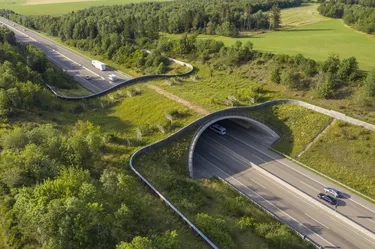
Whether you plan to head on a road trip this summer, spend time at national parks or simply drive near a wooded area, you have a good chance of seeing some wildlife on your journey and maybe even encountering animals crossing the road. From large mammals to small amphibians, the range of animals encountered on the road increases the chance of experiencing a collision that can harm both those in vehicles and the wildlife.
In response to the issue, localities have increasingly made animal crossings that might include an underpass, overpass or even a crosswalk on the street. Learn more about the uses and benefits of this interesting approach as well as some examples.
Video of the Day
Video of the Day
Basics of an Animal Crossing
Although it can come in different forms, an animal crossing often resembles the natural habitat of the types of animals targeted. It's usually in the form of an underpass or overpass resembling a bridge or tunnel with foliage to encourage the animals to use that pathway rather than travel at a random point across a road. The main goal is to keep the animals off the road so that drivers have a lower chance of colliding with them and the animals have a lower chance of injury or death.
Those who engineer the crossings may make special designs for creatures such as crabs, caribou, deer, salamanders, squirrels and even bears, while other crossings may appeal to a variety of animals. For example, an open design with plenty of space appeals to large mammals like deer, while smaller structures work well for cougars.
Along with using the animal crossing for daily travel, animals may use them for migrating in large groups. Certain animals like caribou often feel reluctant to migrate across a standard road and get scared away by the traffic. So not having an animal crossing may discourage migration completely and reduce the chance of these creatures surviving long-term. Some localities have used measures like road ramps to help encourage migration, but well-designed animal crossings have shown more success.
Impact of Wildlife Crossings
If you wonder how scientists know if animals actually use wildlife crossings, they have plenty of evidence of use they can look at visually. For example, observing the animal crossing in person or using a camera has shown a range of animals taking advantage of underpasses and overpasses. The fact that the crossings will have a design aimed to resemble animals' natural habitats – such as with plants and vegetation – helps encourage the use.
Another key piece of evidence involves the reduction in accidents where wildlife crossings are in use. For example, one study from the Western Transportation Institute showed that wildlife corridors cut down on traffic collisions with large animals by as much as 85 to 95 percent. Adding fencing on the road has also been shown to further help reduce collisions – especially when the fence covers a long distance.
Examples of Crossings in Use
You can currently find animal crossings in various forms used worldwide. And while you'll find plenty of crossings that resemble a bridge big enough for large and small animals alike, engineers sometimes get very creative in finding a solution that works for the environment and type of animal.
For example, you'll find underground tunnels for penguins in New Zealand, a rope bridge for birds in Australia and tunnels for salamanders in Massachusetts. California, on the other hand, has special street-level walkways for amphibians. Australia has crab tunnels, while Washington state has a suspension bridge just for squirrels.
Alongside these more creative options, you'll find standard overhead bridges with greenery in wildlife areas in places like Montana, New Jersey, Florida, Washington and Nevada in the U.S. These structures remain popular internationally in places like Germany, Brazil, Australia and the Netherlands too.
Saving Money and Lives
Animal crossings make sense from an economic point of view because they reduce the number of accidents and traffic delays. Moreover, they make it possible for animals to successfully cross the road, allowing them a wider habitat and longer lives.
- State Farm: How Likely Are You To Have an Animal Collision?
- RVshare: Wildlife Bridges: How They Make the Road Safer for All
- The Guardian: How Creating Wildlife Crossings Can Help Reindeer, Bears – and Even Crabs
- Pew Trusts: Wildlife Crossings Can Protect Migrating Animals
- U.S. Fish and Wildlife Service: Frequently Asked Questions about Caribou
- National Geographic: How Wildlife Bridges Over Highways Make Animals—and People—Safer
- Interesting Engineering: 29 of the Most Heartwarming Wildlife Crossings Around the World
- Citizen Times: Bridges for Bears: Do Wildlife Corridors Work?